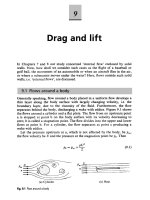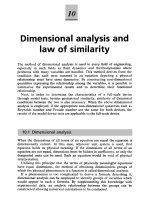Introduction to Mechatronics Mech-1540
Bạn đang xem bản rút gọn của tài liệu. Xem và tải ngay bản đầy đủ của tài liệu tại đây (1.22 MB, 9 trang )
1
1540 Introduction To Mechatronics: Slide 1Hugh Durrant-Whyte
Introduction to Mechatronics
Mech-1540
Sensors 1
1540 Introduction To Mechatronics: Slide 2Hugh Durrant-Whyte
Industrial Sensors
• Proximity
– Mechanical
– Optical
– Inductive/Capacitive
• Position/Velocity
– Potentiometer
– LVDT
– Encoders
– Tachogenerator
• Force/Pressure
• Vibration/acceleration
1540 Introduction To Mechatronics: Slide 3Hugh Durrant-Whyte
Definitions
• Accuracy: The agreement between the actual value and
the measured value
• Resolution: The change in measured variable to which
the sensor will respond
• Repeatability: Variation of sensor measurements when
the same quantity is measured several times
• Range
: Upper and lower limits of the variable that can be
measured
• Sensitivity and Linearity
1540 Introduction To Mechatronics: Slide 4Hugh Durrant-Whyte
Proximity Sensors
• Widely used in general industrial automation
– Conveyor lines (counting,jam detection, etc)
– Machine tools (safety interlock, sequencing)
• Usually digital (on/off) sensors detecting the
presence or absence of an object
• Consist of:
– Sensor head: optical, inductive, capacitive
– Detector circuit
– Amplifier
– Output circuit: TTL, solid state relay
1540 Introduction To Mechatronics: Slide 5Hugh Durrant-Whyte
Mechanical Proximity Switches
• Essentially a
mechanical switch
• On/off operation only
• Two general modes
– Normally Open (NO)
– Normally Closed (NC)
• Come in a wide variety
of mechanical forms
• For a wide range of uses
Actuator
Common
Normally
Closed
Normally
Open
1540 Introduction To Mechatronics: Slide 6Hugh Durrant-Whyte
Example Mechanical Proximity
Switches
2
1540 Introduction To Mechatronics: Slide 7Hugh Durrant-Whyte
When to Use Mechanical
Proximity Switches
• Where physical contact is possible
• Where definitive position is required
• In operation-critical or safety-critical
situations
• Where environment conditions preclude the
use of optical or inductive sensors
1540 Introduction To Mechatronics: Slide 8Hugh Durrant-Whyte
Applications and Use of
Mechanical Proximity Switches
• Easy to integrate into machinery of all types
• Requires contact (thus wear)
• Range of voltages: DC 0-1000V, AC, etc.
• Very robust (explosion proof if required)
• Usually used as:
– Limit switch
– Presence/absence indicator
– Door closed/open
1540 Introduction To Mechatronics: Slide 9Hugh Durrant-Whyte
Places You Find Mechanical
Proximity Switches !
1540 Introduction To Mechatronics: Slide 10Hugh Durrant-Whyte
Optical Proximity Sensors
• Consist of a light source (LED) and light detector
(phototransistor)
• Modulation of signal to minimize ambient lighting
conditions
• Various models: 12-30V DC, 24-240V AC, power
• Output: TTL 5V, Solid-state relay, etc.
Demodulator
Amplifier
Modulator Power
Output
Mixer Signal
Power Supply
Load
1540 Introduction To Mechatronics: Slide 11Hugh Durrant-Whyte
Operational mode:
1540 Introduction To Mechatronics: Slide 12Hugh Durrant-Whyte
Operational Modes
• Through Beam:
– Long range (20m)
– Alignment is critical !
• Retro-reflective
– Range 1-3m
– Popular and cheap
• Diffuse-reflective
– Range 12-300mm
– Cheap and easy to use
3
1540 Introduction To Mechatronics: Slide 13Hugh Durrant-Whyte
Example Optical Proximity I
Optical Fibre
Delivery System
1540 Introduction To Mechatronics: Slide 14Hugh Durrant-Whyte
Example Optical Proximity II
Slot Beam
Systems
1540 Introduction To Mechatronics: Slide 15Hugh Durrant-Whyte
When to use an Optical
Proximity Sensor
• Non-contact, no moving parts, small.
• Fast switching, no switch bounce.
• Insensitive to vibration and shock
• Many configurations available
• Alignment always required
• Can be blinded by ambient light conditions
(welding for example)
• Requires clean, dust and water free,
environment
1540 Introduction To Mechatronics: Slide 16Hugh Durrant-Whyte
Applications of Optical
Proximity Sensors
• Stack height control/box counting
• Fluid level control (filling and clarity)
• Breakage and jam detection
• And many others…
/> /> />1540 Introduction To Mechatronics: Slide 17Hugh Durrant-Whyte
Other Optical Devices
Light
Curtain
Collision Detection
1540 Introduction To Mechatronics: Slide 18Hugh Durrant-Whyte
Ultrasonic Proximity Sensors
• Use sound pulses
• Measures amplitude and time
of flight
• Range provides more than
on/off information
• Frequencies 40KHz-2MHz
Pulse
Echo
Vibrating Membrane
(metal or ceramic)
Sensor
Object
4
1540 Introduction To Mechatronics: Slide 19Hugh Durrant-Whyte
When to use Ultrasonic Sensors
• Provide range data directly:
• Level monitoring of solid and liquids
• Approach warning (collisions)
• Can (usually) work in heavy dust and water
• Ambient noise is potentially an issue
/>1540 Introduction To Mechatronics: Slide 20Hugh Durrant-Whyte
Example Applications
Car Wash
Application
Paper roll
Thickness Monitor
Waste water
flow volume
1540 Introduction To Mechatronics: Slide 21Hugh Durrant-Whyte
Inductive and Capacitive
Proximity Sensors
• Inductive sensors use change in local
magnetic field to detect presence of metal
target
• Capacitive Sensors use change in local
capacitance caused by non-metallic objects
• Generally short ranges only
• Regarded as very robust and reliable
1540 Introduction To Mechatronics: Slide 22Hugh Durrant-Whyte
Example Inductive Sensors I
Detection of
open/close functions
Detection of
rotation
1540 Introduction To Mechatronics: Slide 23Hugh Durrant-Whyte
Example Inductive Sensors II
Bulk mounted inductive
sensors. Detect presence of
object without contact.
Range 3mm +/- 10%
1540 Introduction To Mechatronics: Slide 24Hugh Durrant-Whyte
Example Capacitive Sensors
Panel Mounted Capacitive
Sensor. Can detect wood,
plastic and metal.
Range 3mm-25mm
Flat mounted Capacitive
Sensor. Used for detecting
panels of glass.
Range=10mm +/- 10%
5
1540 Introduction To Mechatronics: Slide 25Hugh Durrant-Whyte
Position and Velocity
Measurement
• Position and velocity measurement
is often required in feedback loops
• For positioning, and velocity control
• Position measurement:
– Potentiometers
– LVDT
– Encoders
• Velocity Measurement:
• Tachometer
1540 Introduction To Mechatronics: Slide 26Hugh Durrant-Whyte
Potentiometers
R
V
in
V
out
An analog sensor
Works as a voltage divider
1540 Introduction To Mechatronics: Slide 27Hugh Durrant-Whyte
Types of Potentiometer
• Wirewound
– Wiper slides along coil of Ni-chrome wire
– Wire tends to fail, temperature variations
• Cermet
– Wiper slides on conductive ceramic track
– Better than wire inmost respects
• Plastic film
– High resolution
– Long life and good temperature stability
1540 Introduction To Mechatronics: Slide 28Hugh Durrant-Whyte
Linear Potentiometers
1540 Introduction To Mechatronics: Slide 29Hugh Durrant-Whyte
When to use a Potentiometer
• Require analog signal for control
• Require absolute positional information
• Low cost
• Temperature and wear variations
• Not in dusty or wet environments
1540 Introduction To Mechatronics: Slide 30Hugh Durrant-Whyte
Linear Variable Differential
Transformer (LVDT)
• An LVDT consists of a magnetic core that moves in a cylinder
• The sleeve of the cylinder contains a primary coil that is driven
by an oscillating voltage
• The sleeve also contains two secondary coils that detect this
oscillating voltage with a magnitude equal to displacement
• The automatic nulling that can be achieved using two coils
makes LVDTs very accurate (submillimetre)
V
in
sin
ω
t
V
out
sin(
ω
t+
φ)
Phase measurement









